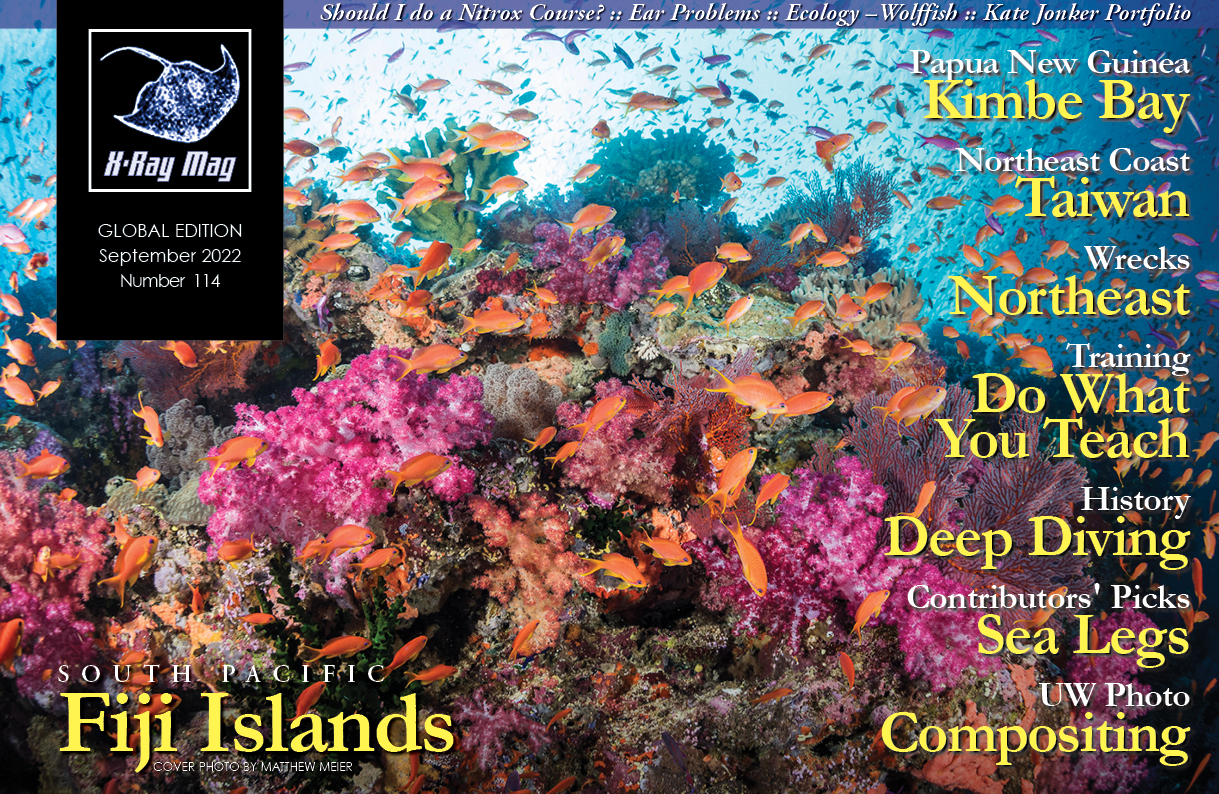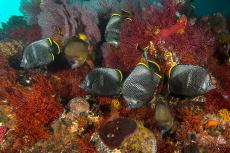Taiwan is a group of Pacific islands surrounded by warm tropical seas. It is easy to get to and get around, and it is also a first-world society with outgoing, friendly, laid-back people. Simon Pridmore gives us a glimpse into the beautiful dive sites and unique marine life that can be found here.
Contributed by
Taiwan offers some very good scuba diving and a network of dive centres and resorts, with first-class professional staff, equipment and services. They offer scuba experiences, basic training courses and fun diving for a young, enthusiastic first generation of Taiwanese divers.
Yet, when divers elsewhere in the world think about diving destinations, Taiwan is unlikely even to be a blip on their radar screen. Very few people outside Taiwan have ever thought to enquire about the diving here, and very few people inside Taiwan have ever thought to tell anyone about it—until a couple of years ago, when some far-sighted folks asked me and Taiwanese underwater photographer Kyo Liu to write a book.
The book is called Dive into Taiwan, and this is the first in a series of six articles, each covering one of Taiwan’s diving regions, designed to give you a flavour of what to expect from a Taiwan dive trip. The book covers much more than diving. It talks about the people, countryside, cities, food and lifestyle to give readers a full immersive experience—diving into Taiwan in every way. But, in this series, I will just focus on the underwater attractions, with the help of Kyo’s amazing photographs.

The Northeast Coast
Japanese marine life guides are the best in the world and feature a huge variety of unusual fish and other undersea creatures. Most of the images in these books were taken in the waters around fabled Iriomote, one of the Ryukyu Islands in Japan bathed by the warm, life-giving Kuroshio ocean current.
The distance between Iriomote and the northeastern coast of Taiwan, which also benefits from the Kuroshio, is less than 200km (124 miles). So, it is hardly surprising that this is an equally happy hunting ground for macro photographers, nudibranch-fanciers, and fans of exotic underwater critters.
The area may not be as internationally famous as Iriomote, but veteran Taiwanese divers know all about it. Drive along the coastal highway on any day of the week in summertime and you will find cars parked here and there along the road. Behind each vehicle will be a hardy-looking diver, sporting beat-up old dive gear, but an expensive newly upgraded camera system.
In the same area, you may also come across groups of wetsuited individuals huddled near open-backed vans, surrounded by piles of equipment and looking very serious. This is because the northeastern coast is where the people of Taipei come to learn to scuba dive.
If you are staying in central Taipei, the dive sites are about an hour’s drive out of town, strung out all along the North Coast Highway.
The diving season on the northeastern coast runs from May to October, when you can expect water temperatures from 27°C to 30°C (80°F to 86°F). In winter, water temperatures drop to between 17C and 22°C (63°F and 72°F), and big waves during this period can make shore entries very challenging.
Protected sites such as Longdong Bay and Bitou Bay are diveable almost all year round though, and hardcore northeastern coast divers insist that, when the sea is a little cooler, the visibility is often better, and you can see the dramatic rock formations and impressive underwater seascapes in all their glory. During the summer season, visibility is usually 5m to 10m (16ft to 33ft). The risk of typhoons is highest in July and August, as is the case everywhere in Taiwan.

Wanghaixiang Bay Area
The fishiest and most colourful diving on the northeastern coast is in Wanghaixiang Bay. There are 11 dive sites here, including the wreck of a trawler, Haijian, in 28m (93ft) and some other metal structures called Steel Reef and Steel House. These were all originally sunk as fish aggregation devices, but the bay is now a designated no-take zone and fishing is not permitted. To help preserve the plentiful fragile soft corals that abound, local dive operations refrain from bringing brand new divers here. Topside, the bay is marked by the distinctive and much-visited Elephant Trunk Rock that sits at the end of a promontory on the southeastern side.
The most beautiful dive site in the bay is called Mimi Huayuan or Secret Garden. There are actually two dive sites here. Secret Garden is the name given to two large rocks absolutely covered in soft corals and sea fans, frequently swept by large schools of fish, that lie a couple of hundred metres or so northeast of the entry point. A second dive called Secret Garden 2 or Rose Garden (after a huge field of pink coral) begins at the same point but takes you in a loop in the other direction.
As soon as you dip your head below the surface, you immediately see the beneficial effects of the fishing ban. Not only are there schools of butterflyfish, porcupinefish, moorish idols and Australian stripey or convict fish (microanthus strigatus), there are large groupers, soapfish, rainbow wrasse, filefish and clouds of damsels everywhere. Moray eels hide among the rocks and scorpionfish hide in plain daylight, their camouflage rendering them almost impossible to see.
The profusion of soft filter-feeding corals and gorgonian fans is far greater here than anywhere else along this coastline. You may also find a rare sea apple or two in the deeper section of Secret Garden.
Schools of porcupinefish (Diodon holocanthus) tend to gather in the bay, which is unusual as they are normally solitary. The theory is that they congregate here to breed in calm waters. There are bigger fish to keep your eyes open for too, including big groupers and broadclub cuttlefish.
The shipwreck and other artificial reefs in Wanghaixiang Bay lie several hundred metres offshore, too far from the shoreline for a comfortable swim, but you can get out there by boat from the Badouzi fishing harbour on the other side of the peninsula. It is only a 10-minute ride from the dock to the site. Boats from Badouzi can also take you out to Keelung Island just offshore, where you will find big gorgonian fans, the occasional frogfish, plenty of schooling fish (such as trevallies, grunts and snappers), and lovely soft corals. The dive site they call Rainbow Reef is as colourful as it sounds.

Longdong Bay Area
As you drive east along the coast, the road curves towards the south and the scenery becomes ever more rugged and beautiful, the farther you go. The mountains that plunge almost directly into the sea here are green and mossy, as are the picturesque ruins of the old gold mining works on the land side of the road, which have been reclaimed by nature and are now completely overgrown. The coastal highway clings to a narrow ribbon of land separating mountain from sea, a thin band that the mountains and the sea are constantly trying to breach.
Longdong Bay is the primary destination for divers here. It has four sites and depths range from those shallower than 5m (15ft) to as deep as 24m (80ft).
If you stop someone with a camera system as they are heading for the waters at Longdong and ask them what they are looking for, they will probably reply, “Nudibranchs.” And it is easy to understand why. The variety is astonishing. There are also plenty of other things for a sharp-eyed critter spotter to look for. You may find cockatoo waspfish, flying gurnard, dwarf scorpionfish, paddleflap rhinopias, lacy rhinopias, flamboyant cuttlefish, blue-ringed octopus, harlequin shrimp, bandtail scorpionfish, mantis shrimp and hairy frogfish, any one of which would be a highlight on a dive pretty much anywhere in the world. But do not always keep your eyes fixed on the seabed. The visibility may not be terrific—10m (33ft) on a good day—but it is good enough for you to get sightings of large schools of trevally, grunts and snappers from time to time.
If the waves are coming in from the northeast and stirring up Longdong Bay, divers will usually head up to Bitou Bay, which opens to the northwest and is very protected. Bitou is especially ideal for snorkelers and newer divers.
Both Longdong and Bitou are excellent night-diving spots, which is one advantage of staying out on the coast during your visit, instead of in Taipei. As is the case everywhere in the tropics, more critters come out to play after dark.
KM82.5
In-between Wanhaixiang Bay and Longdong Bay is a site known as KM82.5. Like all highways in Taiwan, the North Coast Highway has green roadside markers every 100m, and the marker that tells you where this site is reads “82.5.”
The site is quite fishy, although nowhere near as action-packed as Secret Garden, but what you are mainly looking for here, as in Longdong Bay, are smaller critters. Photographers especially love KM82.5, as fewer divers come here.
Guishan/Turtle Island
Guishan or Turtle Island lies 9km (5.5 miles) offshore from Yilan, a town 60km (37 miles) south of Longdong. It is not easy to get a dive boat out to the island, but I include it because it is such a unique dive site. Guishan is uninhabited, part of a maritime ecological park, and the number of visitors per day is limited to preserve the environment.
Guishan is actually the peak of Taiwan’s only active volcano. Geothermal vents on the seabed all around it discharge trickles of hot sulphurous gas into the ocean. It is like diving inside a pot simmering on a stove, and the streams of bubbles serve to warm up the waters a little.

Dive operators
There are two strategies for diving the northeastern coast. You can stay in the centre of Taipei and dive with a city-based dive centre, which will spirit you out of town for a morning’s diving and whisk you back again in the early afternoon.
This may mean that you spend a couple of hours on the road each day but, in the city, you will have a vast range of accommodation choices to fit any budget and, when you get back from your morning’s diving, you will find enough dining and activity options to make your head spin.
If you want to combine a little fine diving with a little fine dining and culture, this is certainly the way to go. There are not many places in the world that offer such an appealing combination of underwater and topside things to do.
The alternative strategy is to stay out on the coast, so you can dive your socks off all day and every day. There are plenty of hotels at various budget levels in the towns of Keelung and Ruifang, where you will be close to Wanghaixiang Bay.
However, if your focus is on KM82.5, Longdong Bay and beyond, then it might be better to base yourself in Longdong or Fulong, where there are several small guesthouses, some run by the local dive centres. The rooms are rudimentary, but they are clean and comfortable. Your dining and topside activity options will be extremely limited, but if you are on a mission to photograph critters and nudibranchs to the exclusion of all else and do not care about the city sightseeing and feasting, then this would be the way to go.













































